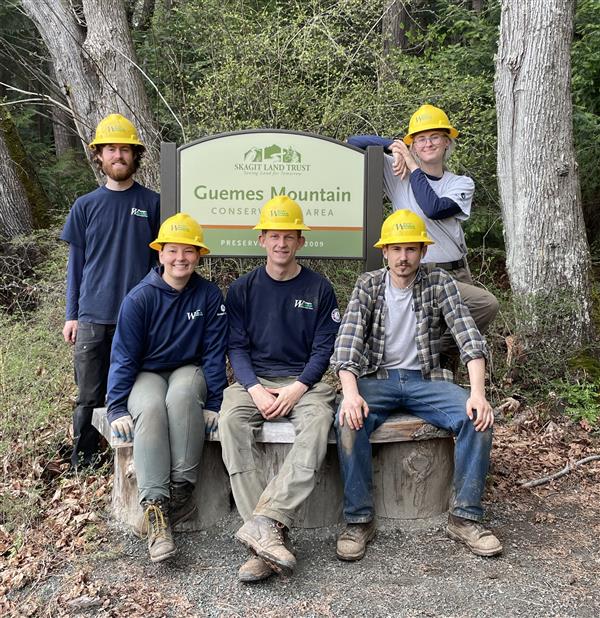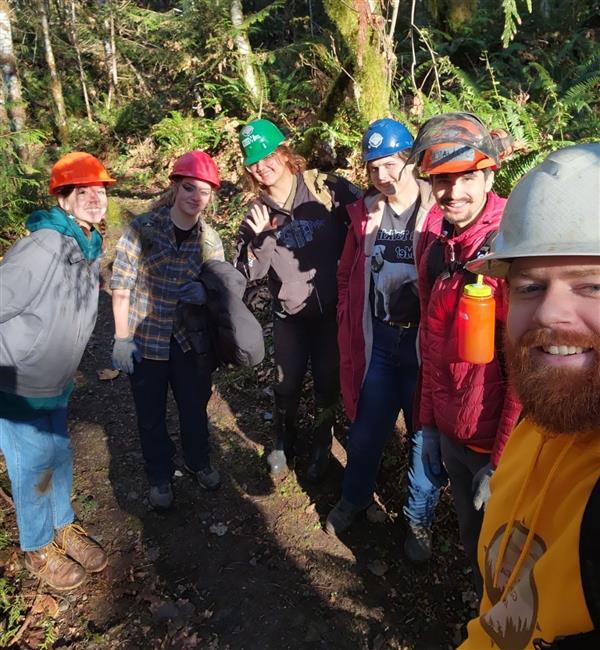At Skagit Land Trust, we are fortunate to collaborate with dedicated conservation program partners who help us protect and restore Skagit County’s special places. This past year, work crews from EarthCorps, the Washington Conservation Corps (WCC), and Glacier Peak Institute (GPI) all added significantly to the amount of skilled stewardship work contributed to Skagit Land Trust lands.
EarthCorps is an AmeriCorps program committed to developing the leadership skills and ecological restoration knowledge of young adults from across the U.S. and abroad. In 2024, EarthCorps supported us with 19 days of crew time across four Conservation Areas. Their teams focused on invasive species control, tackling blackberry at Hurn Field and garlic mustard at Pressentin Ranch and in areas along river shorelines.
Before (top) and after (bottom) photos taken by EarthCorps crews after invasive removal projects in October 2024.
Washington Conservation Corps, another AmeriCorps program under the Department of Ecology, is one of Skagit Land Trust’s most consistent partners. In 2024, we were lucky to have 34 days of WCC crew time across seven of our Conservation Areas. WCC crews provide essential help with stewardship projects that require specialized skills, including stream shoreline restoration, invasive species removal, and trail work.

A WCC crew poses after a day of trail maintenance at our Guemes Mountain Conservation Area.
WCC's efforts have been instrumental in restoring shorebird habitat in Guemes Valley, controlling yellow archangel at Barney Lake, and addressing bamboo and other invasives at Kelly’s Point. Over the years, our staff have learned a lot about restoration from WCC crews, who often have valuable technical expertise to share.
This year, Skagit Land Trust also partnered with Glacier Peak Institute’s new workforce program. Funded by Snohomish County, this job training program provides young adults from the greater Darrington area with conservation skills and experience through hands-on work
opportunities with private conservation organizations, the Forest Service, and local tribes. In 2024, GPI contributed nine days of crew time to three of our Conservation Areas, where they supported projects such as blackberry removal at Utopia and trail maintenance at Barr Creek.

A GPI crew poses for a photo while doing trail work at Barr Creek.
These crews’ experience, skills, and knowledge enables us to pursue more ambitious undertakings. For example, while trail-building on the Hegg-Benson trail at Barr Creek, a GPI crew was able to relocate 65 feet of trail to a new wider and smoother route, remove large tripping-hazard rocks from a trail bed, fell precarious trees after a windstorm, and build rock retaining walls.
SLT’s Americorps volunteer, Emma, observed: “The crew had no problem following the established trail standards, completing the tasks assigned with care, and providing quality work.” GPI Workforce’s Ecological Restoration Crew lead, Dylan, reported that: “SLT staff always had a good plan outlined for us, which was very helpful. And we had a blast!”
EarthCorps, WCC, and GPI crews have brought valuable skills, energy, and passion to work as they help us address a wide range of ecological challenges. Given that the Trust manages thousands of acres of land with a stewardship staff of three, our partners’ contributions also make our stewardship workload much more sustainable.
The opportunity for our staff to mentor the crew and share career insights is also an important part of these partnerships. WCC’s Crew Supervisor, Erika, told us: “It’s been great to work with an organization that understands the educational aspect of WCC, and takes the time to teach the members about the organization’s mission and why projects matter.” By providing this hands-on training in beautiful natural settings, SLT helps to inspire and support the next wave of conservation professionals.
Working together to improve the health of the land also fosters a sense of community and shared purpose. We look forward to continuing to work alongside these dedicated teams to conserve wildlife habitat, agricultural and forest lands, scenic open space, wetlands, and shorelines for the benefit of our community and as a legacy for future generations. Thank you EarthCorps, WCC, and GPI for your ongoing support!